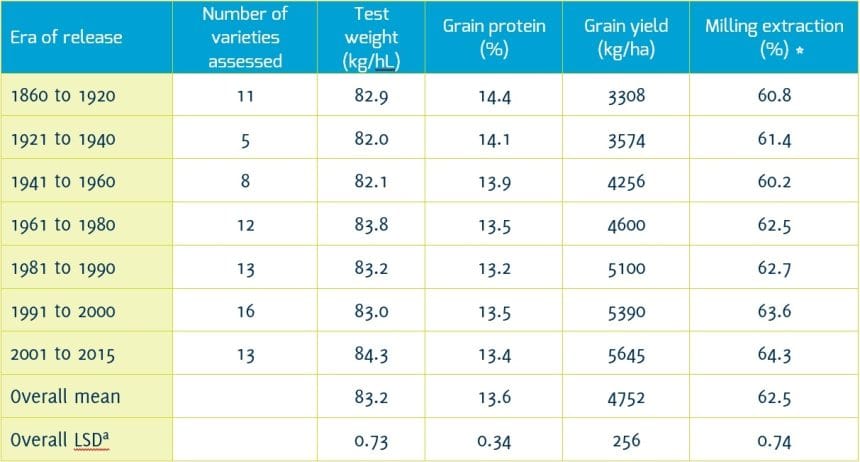Key characteristics of Australian wheat varieties have significantly improved. New varieties offer higher yields, greater grain density and more flour yield.
Recently I stumbled across an interesting PhD thesis1 that outlined changes in the nature of Australian wheat varieties released and grown over the last 150 years. In Table 1 are data extracted from that thesis that illustrate how key characteristics of Australian wheat varieties have changed over the last 150 years.

a LSD = least significant difference. The 78 varieties were sown in field trials in Southern New South Wales, at Kabinga in 2015 and at Collingullie in 2016.
* Milling extraction data has been measured using a Quadramat Junior Test Mill. Wheat sample size was less than 100g and the conditioning level used was 13.5 per cent. The low flour extraction rates reported here are typical for this milling test. Further work would need to be done to confirm the observed improvement in flour milling performance.
Admittedly the data in Table 1 are based on only two years of data and only at 2 sites in southern New South Wales, yet usefully reveal some trends. Grain protein of varieties has slightly reduced, but test weight has slightly improved so a little more weight of grain now fits into each ship hold or rail wagon. Milling percentage also has lifted so each tonne of grain now offers more flour yield to grain processors. However, most clearly, grain yield has greatly increased. The earliest varieties recorded plot yields of 3.3 tha-1 whereas the more modern varieties displayed plot yields of 4.8 tha-1. That’s a 44 percent increase in grain yield.
To place the value of that historical yield improvement in a current context, if Australia’s wheat production in 2022 was 44 percent less (i.e. no yield improvement ever occurred) then the cost to the Australian economy would $8.6 billion. What’s more sobering is that without varietal improvement that $8.6 billion would be an example of an annual revenue foregone. That’s why consistently investing in agricultural R&D is worthwhile; it does pays off and it serves the economic interests of the nation. In this case the cumulative investment in wheat varietal development currently generates several billion dollars of additional annual revenue to the Australian economy.
Moreover, in a world where access to sufficient calories still matters in many countries, it means Australia is able to offer a lot more wheat for export than ever before, due to improvement in the yield of wheat varieties. Also, Australia currently can do that while not allocating additional tracts of its farm land for wheat production as was the case largely up until the early 2000s.
1 Qura Tul Ain Riaz (2020) Changes in Australian Wheat Quality Over the Last 150 Years, PhD thesis, Charles Sturt University. Available here.
Expert grains industry analysis and commentary from AEGIC’s Economics and Market Insight Team on a range of big-picture topics that affect Australia’s export grains sector. Read the Horizons back catalogue.


